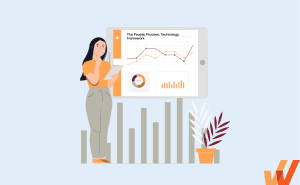Modern businesses face many types of organizational change, from evolving industries, technology advancements, changing business models, cultural shifts, leadership turnover, organization restructures, and more.
For larger organizations, transformational change projects are anything but easy. They require a dedicated change management strategy to prioritize, navigate, and achieve change success.
Change management models enable organizations to progress change projects from idea to implementation. Change models provide proven frameworks that empower leaders with a strategic vision to drive business outcomes from transformational projects.
Change management models are designed to act as compasses that guide organizations through difficult transitional periods and navigate employees to adapt and adopt new processes, ultimately maximizing ROI from change initiatives.
What are the best change management models in 2024?
What Is a Change Management Model?
Change management models are concepts, theories, and methodologies that provide an in-depth approach to organizational change. They guide businesses as they navigate the transformational change process and ensure these changes are accepted, adopted, and correctly used.
Change management frameworks are designed to make change more straightforward and, more importantly, to solidify change as the new norm. They ultimately overcome sources of resistance to change projects and support organizations in driving tangible business outcomes from these transformational, often high-risk investments.
The Importance of Change Models
Understanding the basic principles of popular change management models and frameworks enables enterprises to leverage best practices, tactics, and strategies to lean on when facilitating change projects. Relying on the fundamentals of these change models allows organizations to develop more effective, strategic, and contextual change initiatives.
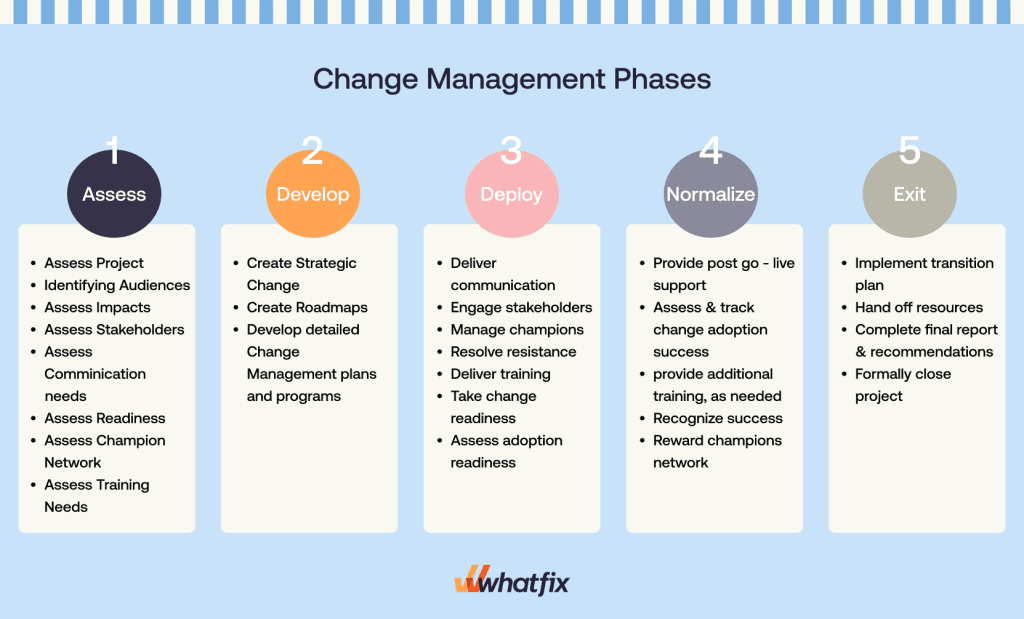
This all impacts your company’s bottom line. Change projects have huge implications that can cause ripple effects across productivity, revenue, customer experience, and more. They are also time and resource-intensive and typically involve new technology investments. This means change projects are costly investments for companies, and relying on the principles of one (or more) change models empowers organizations to navigate large change projects successfully.
10 Most Effective Organizational Change Management Models
Following a proven method for introducing and establishing a change will increase your change management success rate. Various established models exist; the challenge is to find the one that works best for your situation.
Some models are better suited to large-scale, organization-wide changes, such as moving all customer management from various programs into a centralized system within Salesforce. Smaller projects, such as change management examples altering the format of client monthly progress reports sent by the marketing department, might be better suited to a less complex model.
These top models have been proven to be effective. As you consider each, be open to using multiple methods, sometimes simultaneously.
1. Lewin’s Change Management Model
Lewin’s 3-Stage Model of Change, developed by Kurt Lewin who is also credited with the theory behind force field analysis, is popular thanks to its three-phase model that breaks down big changes into more manageable chunks:
- Unfreeze
- Change
- Refreeze
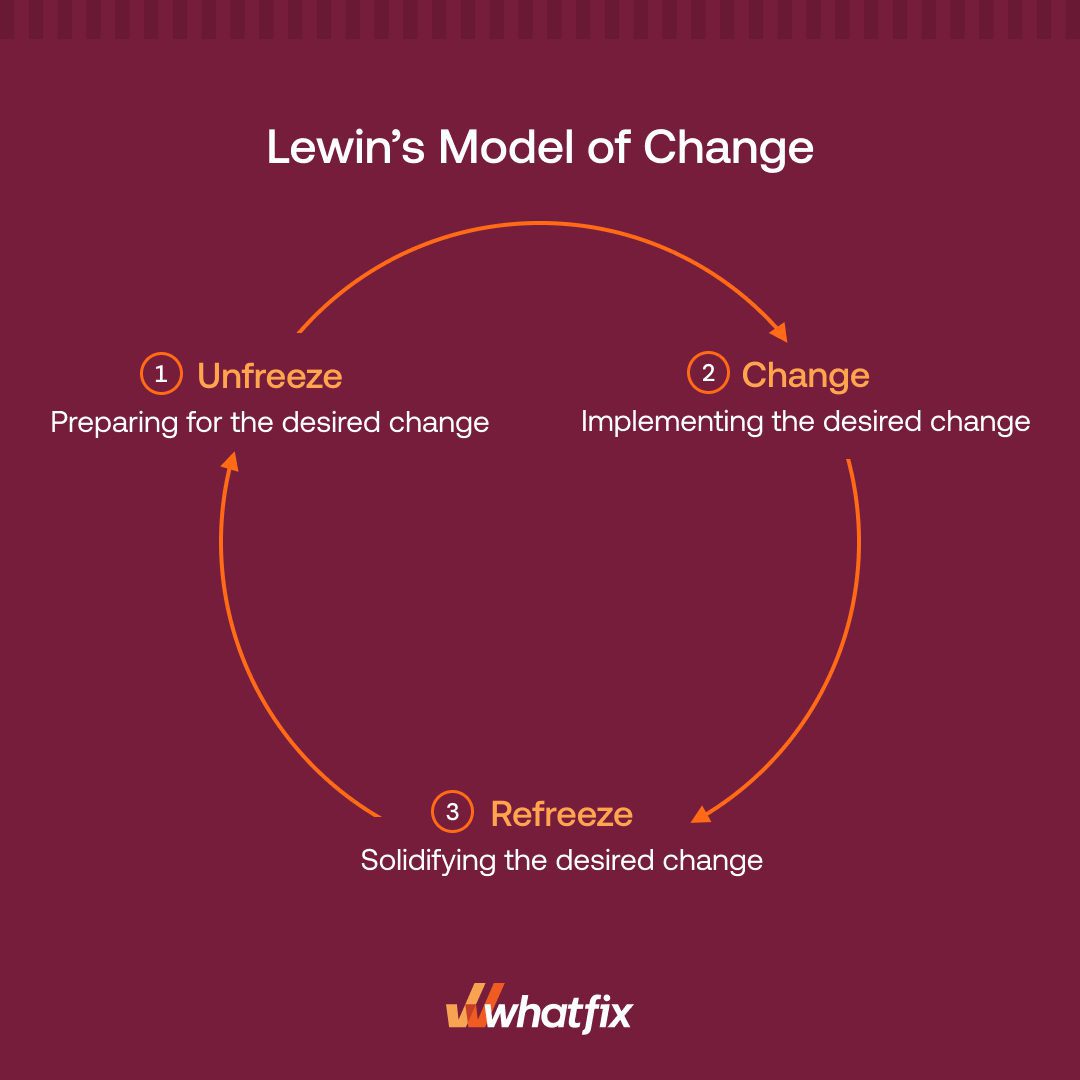
You must first “unfreeze” your current process and analyze how it can be improved so that everyone affected understands the need for change. You then make your changes and guide employees throughout the transition. Once changes have been deployed and tweaked according to employee feedback, you must solidify or “refreeze” the new status quo.
So few phases don’t guarantee a fast transition. The Lewin’s Model often involves spreading out the “change” phase over a long period of time to overcome resistance and provide adequate training. Use this model when you have strong support from senior management and need to make organization- or team-wide changes.
2. McKinsey 7-S Model
The 7 S’s of the McKinsey 7-S Model make it one of the more complex models, but that complexity may be necessary when implementing complicated organization-wide changes. The model’s seven elements are not designed to be addressed in a specific order but rather assessed by how they affect each other so that weaknesses can be identified:
- Strategy
- Structure
- Systems
- Shared Values
- Style
- Staff
- Skills
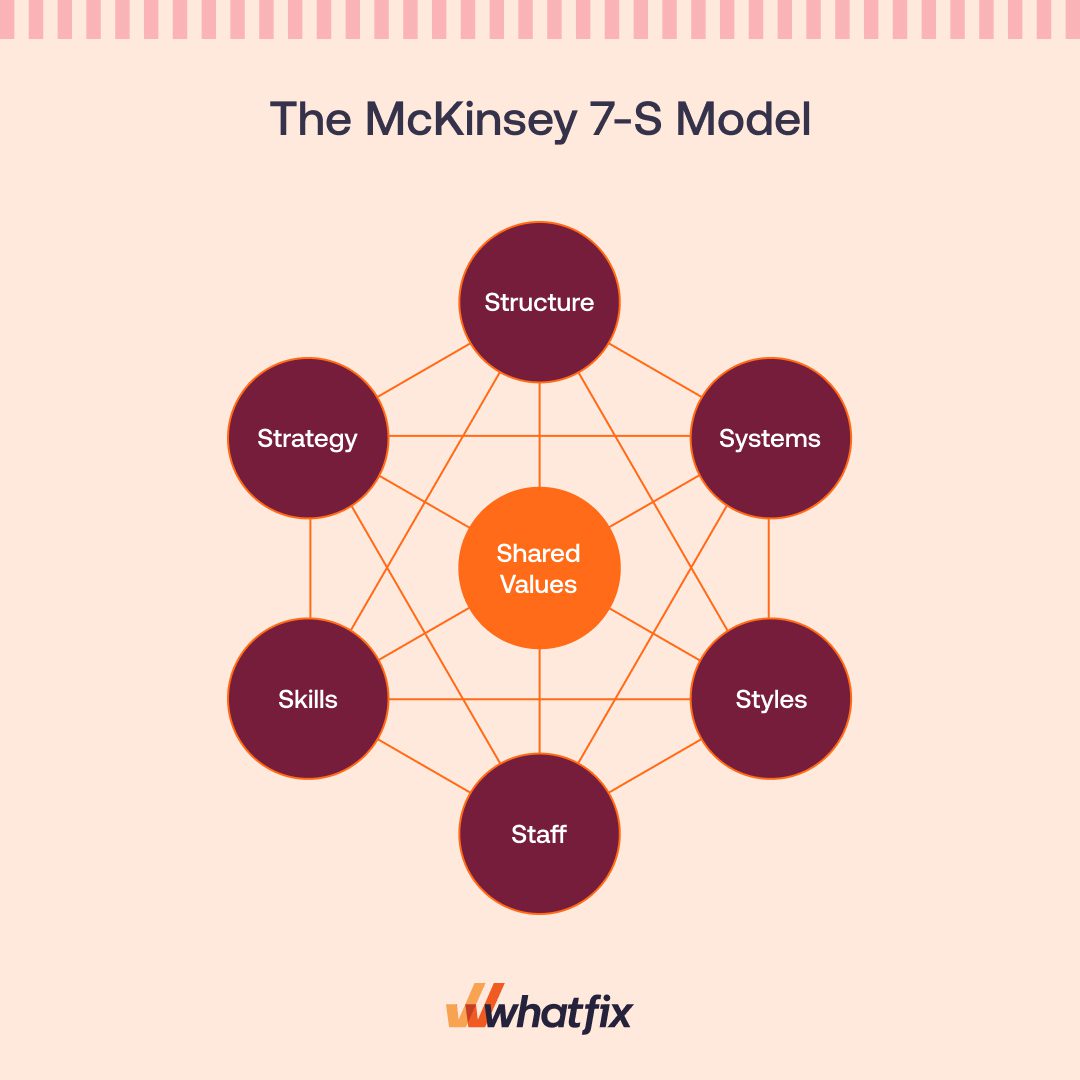
The first three — strategy, structure, and systems — are considered the “hard” elements, meaning they are simpler to identify and easily influenced by management. The hard elements are such things as the company plans to be more competitive (strategy), organizational charts (structure), and routines/processes for how work is to be done (systems).
The remaining four “soft” elements, conversely, are more difficult to describe and are influenced by the company culture. Your staff, their skillsets, the company’s overall leadership style, as well as the values or culture of the company are more fluid and subject to continuous change. The key is to keep all seven elements in harmony by analyzing how they interact with and affect each other.
The McKinsey 7-S model is perfect for when you know there is something wrong within the organization, but you’re not sure how to address the issue. Once you have identified what changes need to be made, the seven elements serve as a guide to keep your company in balance.
This model can help you identify misalignments, such as your company touting a focus on family but not offering paternity leave. It can then help you navigate the implementation of the necessary change, such as ensuring that your staff has the skills to cover responsibilities for anyone who takes advantage of a paternity leave option.
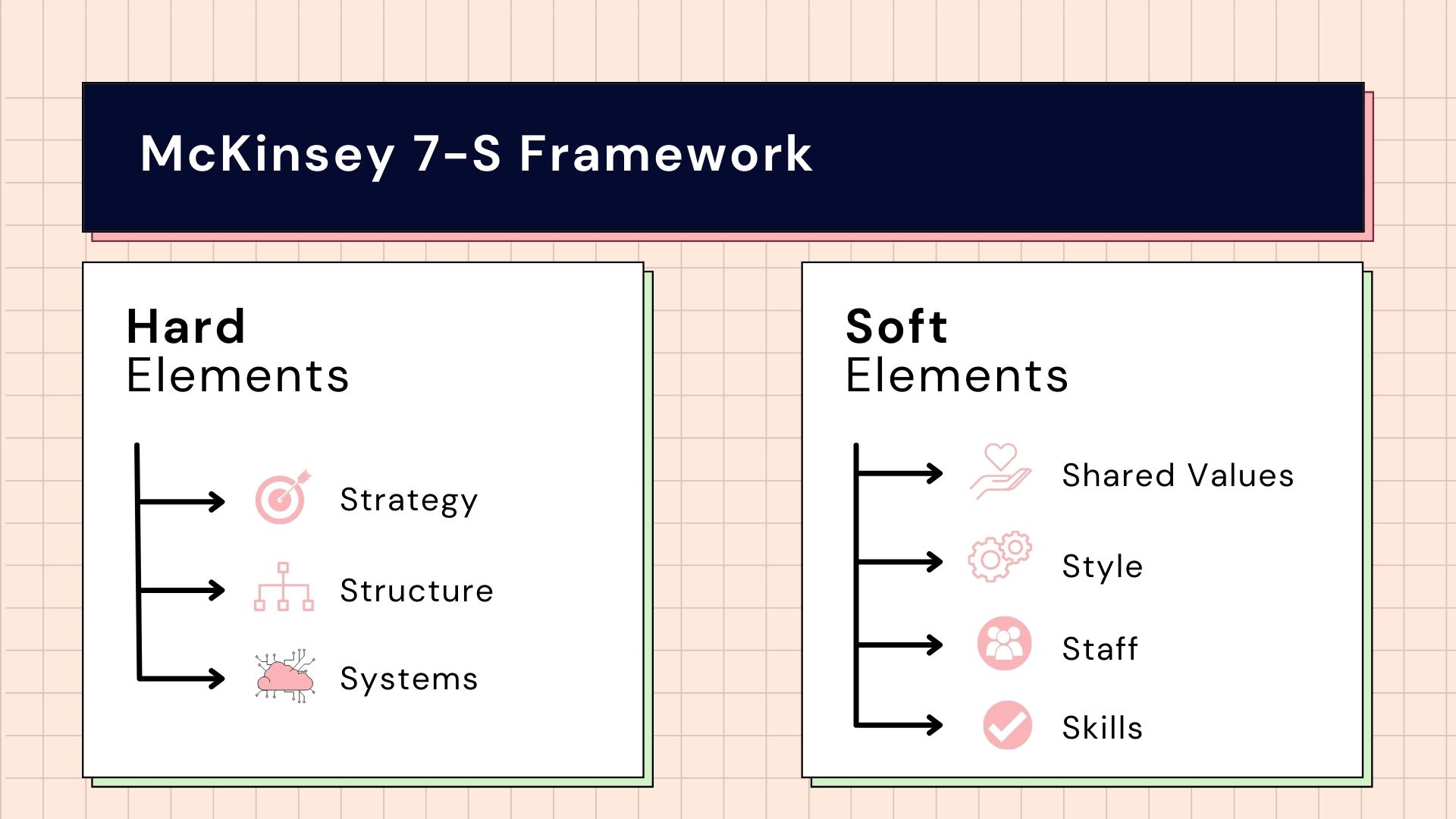
3. Nudge Theory
Nudge theory relies on subtle, indirect suggestions backed up by evidence so that employees will be nudged in the direction of change they desire. The premise is that “nudging” change is more effective than strictly enforcing change. Below are the theory’s basic principles:
- Define changes
- Consider employee point of view
- Provide evidence to show the best options
- Present change as a choice
- Listen to employee feedback
- Limit options
- Solidify change with short-term wins

Nudge theory allows employees to see the need for change for themselves and influence how it is made, making resistance less likely.
Like a parent would with a child, it guides employees towards the options management wants them to choose. The beauty of this change management framework is that it aims to get the full support of your employees, while still making them feel a part of the process of choosing and managing the change.
Nudge theory is best used in conjunction with another model.
4. The ADKAR Change Management Model
The ADKAR Model is a bottom-up method created by Jeffrey Hiatt. It puts the focus on the people behind the change. This is not a sequential method; each letter in the acronym represents a goal to be reached as a company:
- Awareness (of the need to change)
- Desire (to participate in and support the change)
- Knowledge (on how to change)
- Ability (to implement required skills and behaviors)
- Reinforcement (to sustain the change)

By putting the focus on employees, the ADKAR method limits resistance and thus speeds up implementation. Much like the Nudge theory, the ADKAR model values employee input and support. Instead of going to your employees with a mandate for change, you start a conversation to make employees aware of the need for change so that you can convince them that they will benefit from it. This will foster their desire to participate in the implementation.
The method’s knowledge and ability goals are closely linked, but knowledge focuses more on understanding how the change can be made, while ability is about giving employees the confidence they need to complete the transformation. This people-centric method ensures a higher success rate for sustained change compared to methods that do not actively involve the people affected by the change. This framework is best suited for small, incremental changes so that daily routines are not significantly disrupted all at once.
5. Kübler-Ross Change Curve
You will likely recognize the Kübler-Ross Change Curve as it is based on the five stages of grief, which was defined by the psychiatrist Elisabeth Kübler-Ross. By acknowledging that change is often met with emotional reactions (as opposed to more logic-based objections), you’re better prepared during each of the method’s five stages:
- Denial
- Anger
- Bargaining
- Depression
- Acceptance
Employees may move through these stages in random order and even repeat stages. It’s essential to communicate and empathize, so employees feel that you are acknowledging their emotions throughout the journey towards acceptance.
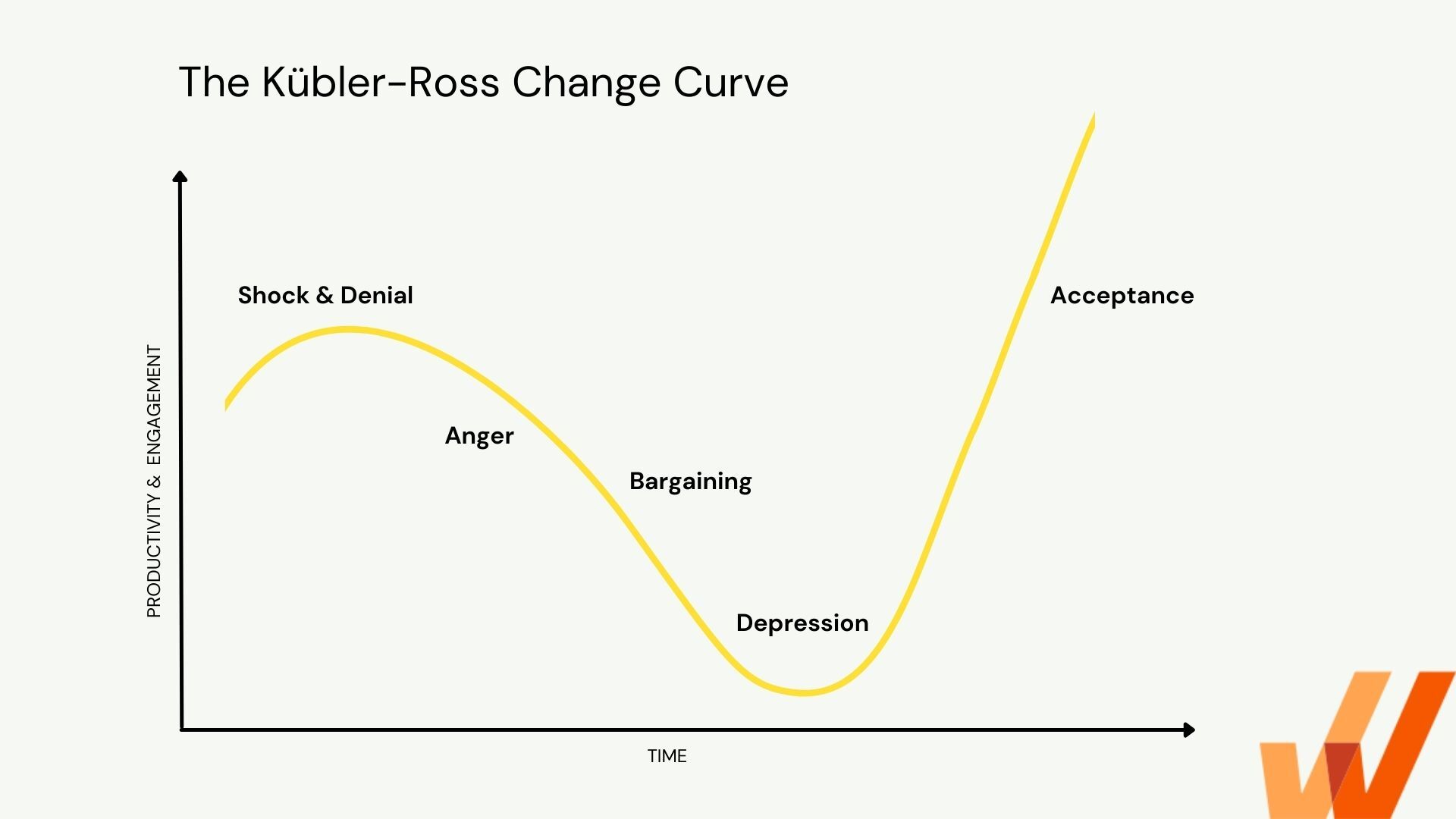
The unpredictability of emotions makes this change management framework ill-suited for large-scale changes.
The Kübler-Ross Change Curve is great for small groups because it allows you to connect with employees on an individual level. Pair this model with another change management framework that outlines clear steps towards the desired result.
6. Bridges’ Transition Model
The Bridges’ Transition Model is similar to the Kübler-Ross Change Curve in that it focuses on the emotional reactions throughout a transition. While many models focus on the change itself, the Bridges’ model narrows in on the transition process by breaking it into three stages:
- Ending, losing, and letting go
- The neutral zone
- The new beginning
The concept behind this model is that change is a thing that happens to people, versus a transition, which is a journey people embark upon. By anticipating the denial, anger, and frustration that comes with change, you can better guide people towards the neutral zone, which is the bridge between the old and new.
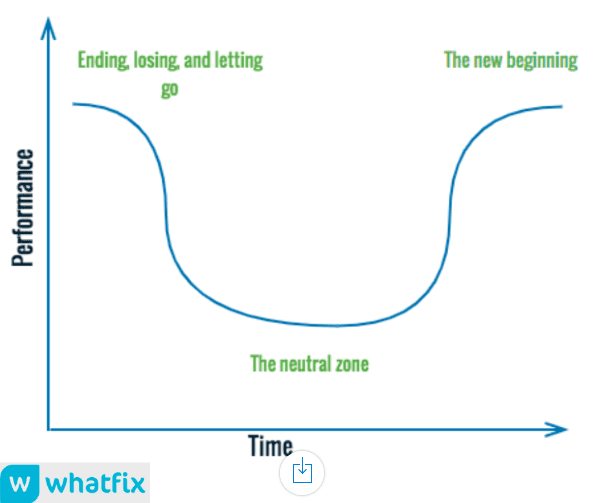
This feelings-based, personal approach helps management and employees work together to transition and solidify change. Once again, taking your employees’ personal feelings into consideration when implementing change guarantees a higher acceptance rate.
The Bridges’ Transition Model is not a checklist but a guide for navigating transitions in a way that pushes employees and management towards excitement and enthusiasm for new beginnings.
7. Satir Change Model
Also related to the Kübler-Ross Change Curve, the Satir Change Model monitors the emotional progression of employees by tracking their performance through five stages:
- Late status quo
- Resistance
- Chaos
- Integration
- New status quo
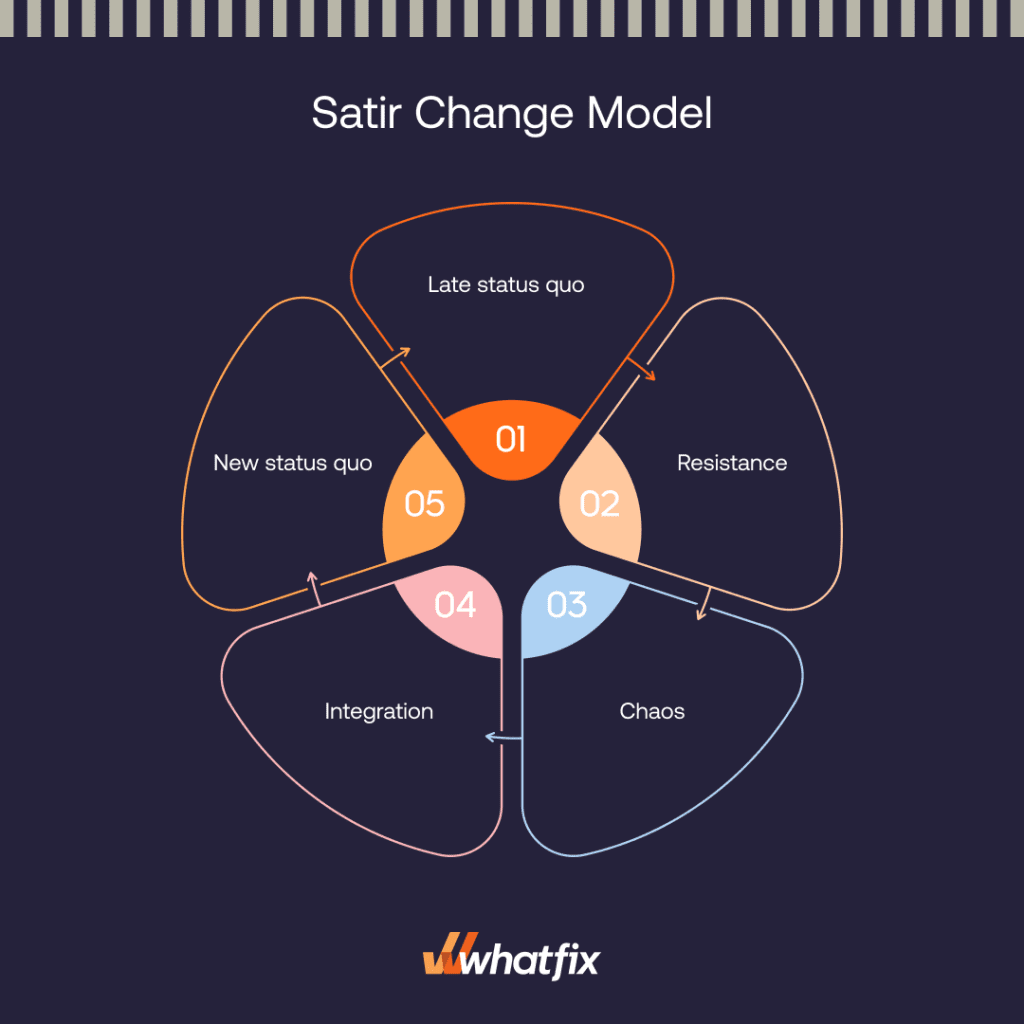
Using a model with a phase called “chaos” might not seem enticing, but there are advantages to anticipating the negative reactions that generally accompany big changes. This model aims to avoid issues that arise when people get frustrated and give up on new processes.
The Satir Change Model focuses on preparation for change but does not help determine what changes need to be made, so it makes sense to use this framework when you know what you want to rework.
This approach acknowledges that many changes are abandoned due to resistance, confusion, and lack of communication, but it does not necessarily provide you with a roadmap to reinforced, sustained change.
8. Kotter’s Theory
Developed by Harvard Business School professor John P. Kotter, Kotter’s Theory for change management is divided into eight stages:
- Create a sense of urgency
- Build the change team
- Form a strategic vision
- Communicate the vision
- Remove barriers to change
- Focus on short-term wins
- Maintain momentum
- Institute change
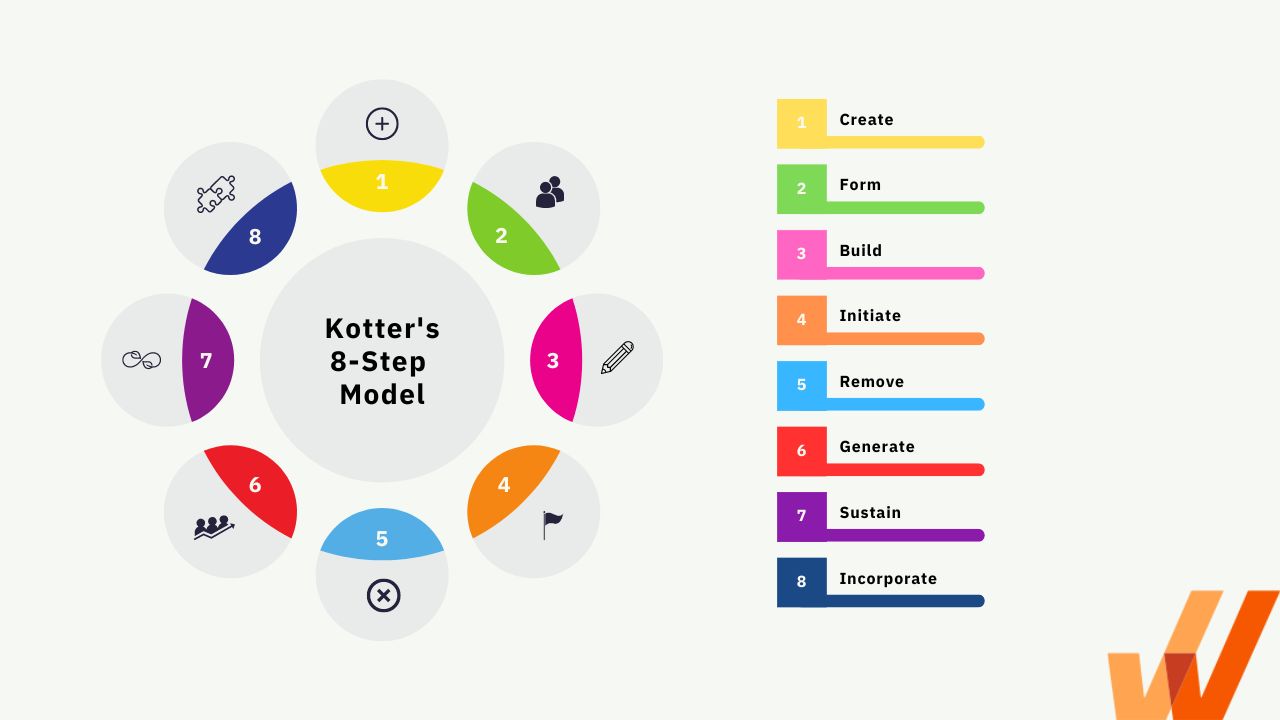
Kotter’s 8-Step Change Model does a great job of building enthusiasm and understanding the need for change by building a checklist that serves as a guide.
However, this top-down model neglects to include a stage that calls for employee feedback, so there is a risk that employee resistance will stall the process.
For larger companies, it can work very well. But for smaller companies, in which feedback is critical and expected, you risk employee resentment and alienation. Pair it with other models that allow for employee feedback throughout the process.
9. Maurer 3 Levels of Resistance and Change Model
The Maurer 3 Levels of Resistance and Change Model is unique in that it centers on what causes changes to fail. This model focuses on three critical levels of resistance:
- I don’t get it
- I don’t like it
- I don’t like you
The creator of this model, Rick Maurer, believes that up to two-thirds of significant changes will fail due to lack of information, negative emotional reactions to change, or lack of trust and confidence in the person or people trying to implement the change.
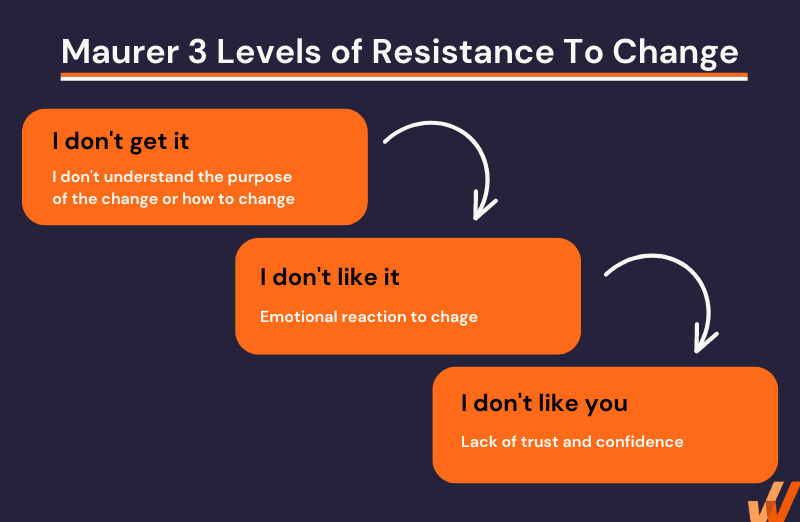
“I don’t get it.”
People are prone to rejecting what they do not understand. When employees do not fully comprehend the need for the change or the change itself, you’ve already set yourself up for failure. It’s critical that employees are given the information that will allow them to see the necessity for the change.
“I don’t like it.”
Emotional reactions can be a huge barrier to implementing change. If employees feel frustrated by or even fearful of the change, they are likely to dig their heels in and resist. Preparing for and managing this expected roadblock is key to moving forward with the change.
“I don’t like you.”
You don’t need to be best friends with the people affected by the change, but if your employees do not trust your judgement and expertise, they may put up more of a fight. If you are confident and informed about the need for change as well as the process for implementing it, your employees will be more receptive.
While the Maurer 3 Levels of Resistance and Change Model is best paired with a step-by-step guide, anticipating and understanding forms of resistance can be incredibly valuable.
10. Deming Cycle (PDCA)
The Deming Cycle, originally developed by Dr. Williams Edwards Deming, is also known as the Plan-Do-Check-Act (PDCA) cycle. This framework focuses on process improvement and is divided into four phases:
- Plan
- Do
- Check
- Act
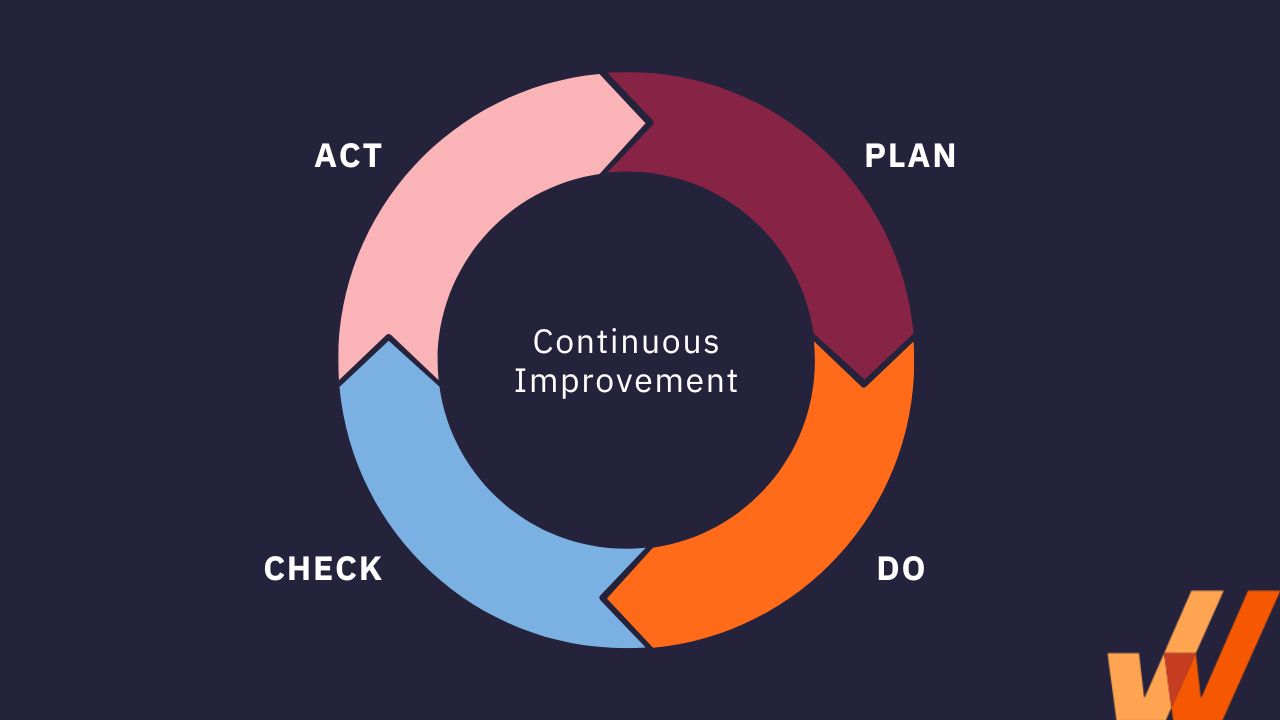
The four phases help you identify the issues that need addressing, tackle those problems through change, and keep the pulse on the implemented changes to see if further action or adjustment is needed.
PDCA is called a cycle instead of a model because it is designed to work on a loop.
You identify issues and potential improvements during the planning stage, then implement them on a small scale, such as within one team or a small department.
You then check and monitor progress to see if this change could benefit from adjustments, and then act accordingly. Acting could mean implementing the change in other areas of the company, or it could mean going back to the planning stage.
This change management framework works best on a small scale, testing changes on a single team or department and tracking change management metrics and results before implementing changes company-wide.
Get a head start on your next change initiative with our change project template pack below:
Change Clicks Better With Whatfix
Change will rarely be welcomed, but proper management can minimize negative reactions. Choose a change management model that functions as a compass pointing you towards your “True North” or desired outcome, and the path to successful change adoption will be much easier to navigate.
Continued support throughout a change is essential, especially with big changes such as adopting new software. Leveraging the right change management tools can help you attain the support you need for major changes in the organization.
Whatfix is designed to provide interactive guidance to educate and support users to ensure smooth transitions.
Learn more about Whatfix now and how it can help guide your teams toward successful, sustained change.



